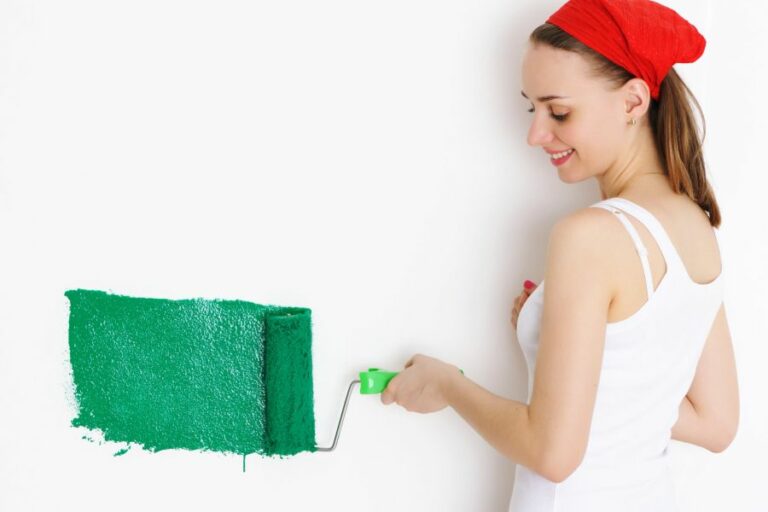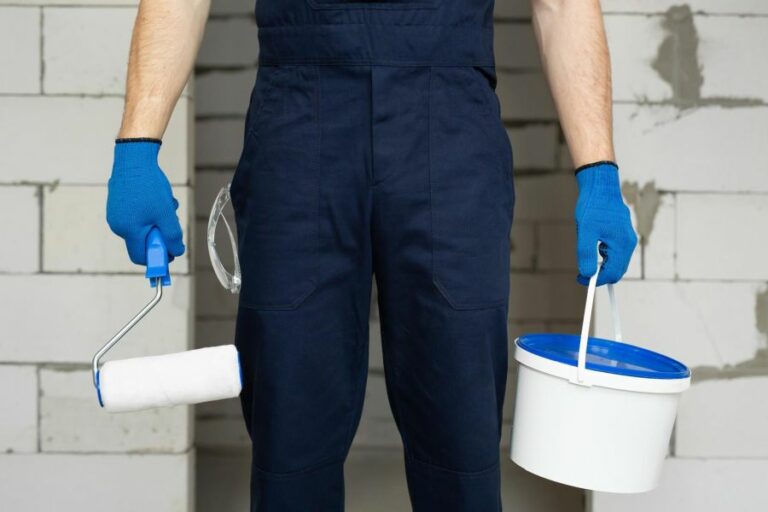Environmentally-Friendly Oil-Based Indoor Paints. What Pros Say
Are you ready to transform your living spaces while also reducing your environmental impact? Let me introduce you to environmentally friendly oil-based indoor paints, prepared with our planet’s well-being in mind. These innovative paint solutions are perfect for those who appreciate quality and style but also care about the eco-footprint they leave behind.
Environmentally friendly oil-based indoor paints:
Environmentally friendly oil-based indoor paints, such as low VOC paints, offer numerous benefits, including improved indoor air quality, reduced environmental impact, durability, and a wide range of colors and finishes. Brands like ECOS Paints and AFM Safecoat provide eco-friendly oil-based paint options that contribute to a healthier living space and planet.

Curious about eco-friendly oil-based indoor paints? You’ve come to the right place! I’ve got the scoop on healthier, sustainable paint options that will brighten up your home while being kind to the environment.
Discover these remarkable products’ benefits and learn how to make the switch today. Read on for more!
Contents
- 1 Eco-Friendly Oil-Based Paints for Indoor Spaces
- 2 Discover the Most Eco-Friendly Paint Options
- 3 Environmental Impact of Oil Paints: A Guide
- 4 Low-VOC Oil-Based Paint: A Safer Alternative
- 5 The Environmental Benefits of Oil Paints
Eco-Friendly Oil-Based Paints for Indoor Spaces
• Introduction to Oil-Based Paints
Traditional oil-based paints have been popular for centuries due to their durability and smooth finish. However, they have also been known to contain volatile organic compounds (VOCs), which can be harmful to the environment and human health.
In recent years, there has been a growing demand for eco-friendly alternatives to traditional paints.
• Low VOC Oil-Based Paints
One of the main reasons for the development of environmentally friendly oil-based indoor paints is to reduce the levels of VOCs. VOCs are emitted as gases from certain types of paint and contribute to air pollution.
Prolonged exposure to VOCs can lead to health issues, such as headaches, irritation, and even damage to the liver, kidneys, or central nervous system.
Thankfully, there are now low-VOC oil-based paints available on the market. These paints have reduced levels of harmful chemicals, making them a safer and more environmentally friendly choice for indoor use.
An example of low VOC oil-based paint is ECOS Paints, which offers a line of eco-friendly oil-based paints with low VOC levels.
• Benefits of Environmentally Friendly Oil-Based Paints
– Healthier Indoor Air Quality
Using eco-friendly oil-based paints can significantly improve the indoor air quality of your home. By choosing paints with reduced levels of VOCs, you are reducing the risk of respiratory illnesses, such as asthma, allergies, and other respiratory issues.
– Reduced Environmental Impact
By opting for environmentally friendly oil-based indoor paints, you are helping to reduce your carbon footprint and the impact on the environment. Lower levels of VOCs contribute to decreased air pollution and smog, thus promoting better air quality and a healthier ecosystem.
– Durable and Long-Lasting Finish
Despite being environmentally friendly, these low VOC oil-based paints still provide a durable, long-lasting finish. They have excellent resistance to scuffs, stains, and wear, making them ideal for high-traffic areas.
– Wide Range of Colors and Finishes
Eco-friendly oil-based indoor paints come in a wide range of colors and finishes, allowing you to achieve the desired aesthetic for your living space. In addition, these paints provide excellent coverage, ensuring a high-quality result for any project.
• Considerations When Using Eco-Friendly Oil-Based Paints
– Proper Ventilation
Although these paints have lower levels of VOCs, there may still be some odor and off-gassing during the painting process. It is important to ensure proper ventilation when using these paints to minimize the impact on indoor air quality.
– Paint Disposal
Disposed paint can have a negative impact on the environment if not done correctly. Be sure to follow local guidelines for paint disposal or contact your local recycling center for more information on eco-friendly disposal options.
– Cost
Environmentally friendly oil-based paints can be more expensive compared to traditional oil-based paints. However, the investment in these eco-friendly options is worthwhile considering the long-term benefits to your health and the environment.
• Recommendations for Environmentally Friendly Oil-Based Indoor Paints
Based on my experience, I highly recommend using low-VOC oil-based paints for your indoor painting projects. Not only do they provide an excellent finish, but they also contribute to a healthier indoor environment and less impact on the environment.
Brands such as ECOS Paints and AFM Safecoat offer a wide range of eco-friendly oil-based paints to choose from.
To learn more about environmentally friendly paint options, visit the United States Environmental Protection Agency website, which provides helpful information on VOCs and tips for selecting eco-friendly paints.
In conclusion, making the switch to environmentally friendly oil-based indoor paints can significantly improve your indoor air quality and contribute to a healthier environment.
By choosing these eco-friendly options, you are not only improving the aesthetic of your space but also investing in the well-being of yourself, your family, and the planet.
Discover the Most Eco-Friendly Paint Options
As a painting expert with years of experience in the field, I can say that paint manufacturers have made tremendous strides in developing eco-conscious solutions for your walls. It is important to select the right paint to not only achieve your desired aesthetic but also to minimize your carbon footprint.
• Natural Paints: High Performance and Sustainability
Natural paints are a popular option due to their low VOC (volatile organic compounds) content, which means less harmful emissions are released into the atmosphere during the painting process. These paints are made from naturally occurring raw materials like clay, plant oils, and resins.
I recommend BioShield and Earth Pigments as reputable manufacturers of natural paints, owing to their commitment to sustainability and impressive catalog of eco-friendly products.
– Clay-based Paints
Derived from earth minerals, clay-based paints boast a number of desirable characteristics, such as excellent durability, breathability, and hypoallergenic properties. They’re perfect for interior walls and ceilings.
Consider the Unearthed line of clay paints, which provide a wide variety of colors, superior coverage, and are completely compostable.
– Lime Washes
Lime washes originated as a traditional Mediterranean paint option, suitable for both interior and exterior applications. Their naturally high pH content makes them resistant to fungus and mold, making them a long-lasting, eco-conscious option for your walls.
Portola Paints & Glazes offers a high-quality Roman Clay product, which comes in a variety of earthy colors and promotes excellent breathability on your walls.
• Low-VOC and No-VOC Paints: Cleaner Air for Improved Health
While natural paints are a great route to minimize environmental impact, these may not be suitable for all projects or budgets. In such cases, Low-VOC and No-VOC paints are the next best options for an eco-friendly paint job.
– Low-VOC Paints
As the name suggests, Low-VOC paints contain a reduced amount of volatile organic compounds. By choosing a Low-VOC paint, you can reduce harmful emissions and minimize the risk of negative health effects associated with poor indoor air quality.
Benjamin Moore offers the Eco Spec line, which is not only Low-VOC but also has antimicrobial properties that improve indoor air quality even further.
– No-VOC Paints
No-VOC paints are designed to contain zero volatile organic compounds, ensuring top-notch air quality for you and your family. These products are ideal for those who are sensitive to paint fumes or suffer from respiratory issues.
AFM Safecoat is a trusted brand known for its high-quality No-VOC paints. Their water-based products not only emit fewer pollutants but also allow for easy cleanup, which equates to less environmental waste.
• Milk Paints: A Time-Tested Classic
Milk paint has been in use for centuries and is made from milk protein, lime, and natural pigments. It is a biodegradable and eco-friendly alternative that can be used for both interior and exterior projects. Moreover, milk paint is a perfect option if you’re seeking a truly authentic, aged look for your home.
A recommended source for milk paint is The Old Fashioned Milk Paint Company, which utilizes sustainable, organic ingredients in its products.
• Tips for a Greener Paint Job
- Choose lighter colors, as they typically require less tint, which reduces VOC levels.
- Dispose of paint responsibly, as suggested by your local waste management facility or through a paint recycling program.
- Invest in high-quality paintbrushes or rollers that will last longer, thus minimizing waste.
- Calculate your paint needs accurately to avoid over-purchasing and potential waste.
In conclusion, there are a variety of environmentally friendly paint options available for those who wish to reduce their carbon footprint. By selecting natural, low-VOC, or no-VOC paints, you will not only minimize harmful emissions but also promote better air quality within your home.
Paint Type | Description | Environmentally Friendly |
|---|---|---|
Water-based Paints | Low VOC content, easy cleanup with water | Yes |
Natural Paints | Made from natural ingredients, minimal chemicals | Yes |
Zero VOC Paints | No volatile organic compounds, better air quality | Yes |
Recycled Paints | Produced using leftover paints, reducing waste | Yes |
Low VOC Paints | Lower levels of volatile organic compounds | Yes |
Environmental Impact of Oil Paints: A Guide
Oil paints have been the medium of choice for many artists since their inception during the Renaissance. Their distinctive qualities, such as rich colors, texture, and opacity, are coveted by painters worldwide. But as with any product, there may be concerns about their impact on the environment.
• Raw Materials and Environmental Impact
The primary components of oil paints are pigments, binders, and drying oils (usually linseed oil). Some of these materials, particularly pigments, can be toxic to both humans and the environment.
The most common toxic pigments are heavy metal-based ones, such as lead white, mercury-based vermilion, or cadmium colors. Although many of these pigments have been replaced or are being phased out, some artists still use them today.
While various environmental protection agencies regulate the production and use of toxic pigments, improper waste management may result in these harmful substances leaching into soil and water sources.
To minimize this risk, the U.S. Environmental Protection Agency recommends proper disposal of materials containing heavy metals, such as using hazardous waste facilities.
• Volatile Organic Compounds (VOCs) and Indoor Air Quality
An additional environmental concern regarding oil paints is the use of solvents and thinners, such as turpentine or mineral spirits. These substances contain volatile organic compounds (VOCs), which evaporate into the air and contribute to smog and indoor air pollution.
Prolonged exposure to VOCs can lead to health problems, such as respiratory and neurological issues.
I recommend using alternatives to traditional solvents, like odorless mineral spirits, which are available at most art supply stores. Additionally, ensure your painting area is well-ventilated to avoid the build-up of VOCs in your workspace.
• Waste Disposal and Recycling
An essential aspect of environmental responsibility is disposing of waste materials appropriately. Oil paint waste, such as used paint rags, palette scrapings, and leftover paint, should not be thrown directly in the trash or washed down the sink.
This may contaminate water sources and pose risks to aquatic life. Instead, designate a separate container for your oil painting waste materials and dispose of them in hazardous waste facilities.
Moreover, recycling or upcycling is another useful approach to minimize waste. Consider reusing empty paint tubes, reusing or donating cleaned empty jars, and collecting paint-encrusted palette paper or dried paint peelings for mixed-media work or home decor projects.
• Sustainable and Environmentally Friendly Options
For artists seeking sustainable and environmentally friendly oil painting options, there are solutions. Some manufacturers now produce eco-friendly oil paints that use organic or natural pigments, such as those derived from plants or minerals, and organic binders.
These paints have lower toxicity levels and use recyclable or biodegradable packaging, reducing their overall environmental impact.
Furthermore, artists can also choose to create their oil paints by sourcing raw materials and mixing them in their studios. Handmade oil paints allow artists to control the quality of the ingredients and reduce packaging waste.
When making your paints, opt for non-toxic or natural pigment alternatives and use minimal amounts of VOC-containing solvents.
• Conclusion
Oil paints do have potential environmental consequences, primarily through the use of toxic pigments and VOC-emitting solvents.
However, artists can take steps to minimize their ecological footprint by using eco-friendly paint options, proper waste management, and adopting more sustainable studio practices.
By being conscious of our material choices and mindful of our waste disposal habits, we can still appreciate the beauty and unique characteristics of oil paints without causing unnecessary harm to the environment.
Low-VOC Oil-Based Paint: A Safer Alternative
• Understanding Volatile Organic Compounds (VOCs)
Volatile Organic Compounds, or VOCs, are organic chemicals commonly found in many products, including paints. These chemicals have a high vapor pressure, which means they easily evaporate at room temperature.
When this evaporation occurs, VOCs are released into the air, causing potential health hazards like respiratory issues, headaches, and nausea. In the painting industry, there is an increasing push to develop and promote low-VOC paint options.
The Environmental Protection Agency (EPA) has set regulations to limit the amount of VOCs present in paints, but the demand for even lower VOC options continues to rise.
• Oil-Based Paints and VOCs
Traditionally, oil-based paints have been known for their high VOC content. This is due to the petroleum-based solvents in the formulation, which are necessary for the paint to dry properly. As a result, oil-based paints tend to emit strong odors and release more VOCs into the air during the drying process.
In response to growing health concerns and environmental regulations, paint manufacturers have focused on creating alternatives with lower VOC levels.
One such alternative is water-based (or latex) paint, which has become more popular due to its lower VOC content, faster drying time, and easier cleanup.
However, many professionals and DIYers still prefer the durability, ease of application, and smooth finish provided by oil-based paints, leading to a demand for low-VOC oil-based options.
• The Advent of Low VOC Oil-Based Paints
Though highly sought-after, low VOC oil-based paint options have historically been limited or difficult to locate. However, recent advancements in paint technology have led to the development of more environmentally friendly options.
One such advancement is the introduction of alkyd resin technology. When combined with water instead of petroleum-based solvents, these resins can create low-VOC oil-based paint with significantly reduced harmful emissions.
This paint maintains many of the desirable characteristics of traditional oil-based paint but with a more sustainable and eco-friendly profile.
Examples of low VOC oil-based paints that utilize alkyd technology include:
- Benjamin Moore Advance Interior Paint
- Sherwin-Williams ProClassic Waterborne Interior Alkyd
- Behr Alkyd Semi-Gloss Enamel Paint
These paints have been increasingly popular among professionals and DIYers, as they provide the preferred finish of traditional oil-based paint without the same harmful emissions.
• Benefits of Low-VOC Oil-Based Paints
By opting for low VOC oil-based paint, users experience several benefits, including:
- Improved Air Quality: Low VOC paint significantly reduces the amount of harmful chemicals released into the air during the painting process. This can lead to better air quality in your space and fewer health concerns for occupants.
- Reduced Odor: Lower VOC content translates to a less potent odor, making the painting experience more pleasant and comfortable.
- Similar Performance: As mentioned earlier, low VOC oil-based paints utilizing alkyd resin technology maintain many of the desirable qualities of traditional oil-based paint, such as durability and a smooth, even finish.
• Potential Drawbacks of Low-VOC Oil-Based Paints
Despite the benefits mentioned, there are potential drawbacks to consider when choosing low-VOC oil-based paint:
- Higher Cost: Due to the specialized technology involved, low-VOC oil-based paints can be more expensive than traditional oil-based paints or even water-based alternatives.
- Limited Options: While the market for low VOC oil-based paint continues to grow, options remain somewhat limited in comparison to their traditional counterparts.
• Final Thoughts
The increasing demand for healthier, eco-friendlier alternatives to traditional oil-based paints has led to the development of low-VOC oil-based paint options that utilize alkyd resin technology.
While these paints may come at a higher cost and with limited options, they provide a viable solution for those seeking the performance of oil-based paint without sacrificing air quality and occupant health.
As the market for these products grows, we can anticipate further advancements in paint technology to offer even safer and more sustainable options without compromising performance.
The Environmental Benefits of Oil Paints
As an experienced artist and an advocate for the environment, I am often asked about the environmental impact of various art supplies.
Today, let us focus on a major question: Are oil paints better for the environment? To address this, I will discuss the composition of oil paints, compare them with other types of paints, and give advice on practicing eco-friendly painting techniques.
• Composition of Oil Paints
Typically, oil paint is composed of three main components: the pigment, the binder, and the solvent. Understanding how each of these ingredients affects the environment will help us determine their eco-friendliness.
– Pigments
Pigments are responsible for the color in paints, and they can be derived from a wide range of natural and synthetic sources. Some pigments have a minimal environmental impact, while others, like cadmium and lead, can be toxic and harmful to both people and the environment.
Fortunately, many paint manufacturers have recently introduced alternatives to these toxic pigments, making it easier for artists to choose eco-friendly options.
– Binders
Linseed oil is the most common binder used in oil paints, which is made by pressing flax seeds. While it’s a natural and renewable resource, the cultivation of flax involves the use of pesticides and fertilizers that can harm the environment.
However, it’s worth noting that linseed oil causes less harm than other binders like acrylic polymers derived from petroleum.
– Solvents
Turpentine and mineral spirits derived from petroleum are the traditional solvents used to thin oil paints and clean brushes. These highly volatile solvents evaporate into the air, releasing harmful VOCs (volatile organic compounds) that can contribute to air pollution.
• Comparing Oil Paints to Other Types of Paints
Now that we understand the composition of oil paints, let’s compare them with other common types of paints used by artists:
– Watercolors
Watercolor paints are made from pigments, gum arabic (a natural binder), and water. Since watercolors do not use solvents and can be easily cleaned with water, they are generally considered more environmentally friendly than oil paints.
– Acrylics
Acrylic paints are water-based, but they contain synthetic polymers, which are derived from petroleum, as their binder. While acrylics do not require traditional solvents, they do require water to clean brushes and other tools.
Acrylic paint enters the wastewater, and it is non-biodegradable, which can have a negative impact on aquatic life and the environment.
– Gouache
Gouache, also a water-based paint, shares a similar composition to watercolors but contains more pigment and an additional white substance to create opacity. Due to its water-soluble nature and the absence of synthetic binders, gouache is considered eco-friendly, similar to watercolors.
• Eco-Friendly Painting Techniques
To mitigate the environmental impact of your artistic endeavors, consider these recommendations when using oil paints:
- Choose eco-friendly supplies: Opt for natural pigments and avoid toxic ones, like cadmium and lead. Look for linseed oil derived from organically grown flax seeds to limit pesticide and fertilizer use.
- Use alternatives to traditional solvents: Replace turpentine and mineral spirits with low-VOC solvents, like citrus-based thinners or water-miscible oil paints, which can be thinned and cleaned with water.
- Practice sustainable disposal: Never pour solvents, oils, or paint residue down the sink. Instead, allow waste to evaporate or solidify and dispose of it as hazardous waste.
- Reuse and recycle: Reuse solvents by allowing pigment to settle at the bottom of a container, then decanting the clear solvent for future use. Similarly, recycle shipping materials and packaging.
- Educate yourself: Stay informed about new and eco-friendly materials and techniques. The US Environmental Protection Agency offers helpful resources on recycling and waste reduction.
• In Conclusion
While oil paints may not be the most environmentally friendly option compared to water-based paints like watercolors and gouache, it is possible to make better choices within the realm of oil painting.
By selecting eco-friendly ingredients, embracing sustainable practices, and staying informed, artists can do their part to protect the environment while pursuing their passion for art.







